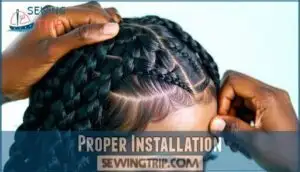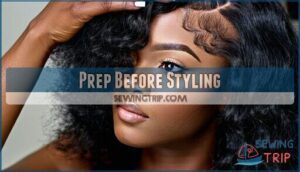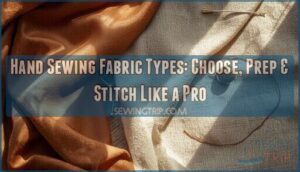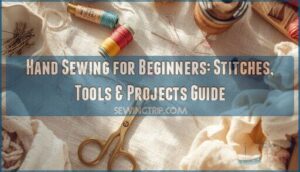This site is supported by our readers. We may earn a commission, at no cost to you, if you purchase through links.
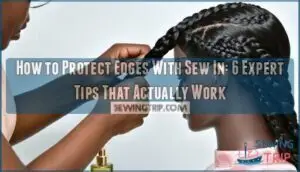
Tell your stylist to keep those braids loose – tight cornrows are your edges’ worst enemy. Sleep with a silk scarf or bonnet to prevent friction. Don’t tug or pull when styling your leave-out hair.
Choose quality extensions that won’t weigh down your natural hair. Most importantly, give your edges breathing room between installs.
Think of your hairline like delicate flower petals that need gentle care to bloom. Your future self will thank you when your edges stay thick and healthy. Smart preparation and aftercare techniques can make all the difference in your hair journey.
Table Of Contents
Key Takeaways
- Keep your braids loose and moisturize daily – You’ll protect your edges by insisting your stylist doesn’t braid too tight and applying lightweight oils, like castor or jojoba, to your hairline every night to prevent dryness and breakage.
- Invest in quality extensions and proper installation – You can’t protect your edges with cheap synthetic hair that causes irritation, so choose high-grade human hair extensions and limit installs to 2-3 months maximum, with proper weave caps for breathing room.
- Sleep with silk protection and handle gently – You’ll prevent friction damage by wrapping your edges in a silk scarf or bonnet overnight and using gentle brushing techniques with a boar bristle brush, instead of rough handling.
- Give your edges breaks between styles – You should alternate between sew-ins, wigs, and crochet styles to let your hairline recover from tension, treating your edges like delicate flowers that need rest to stay healthy long-term.
Quality Extensions
You can’t protect your edges with cheap extensions that feel like straw and look even worse.
Your edges deserve better than bargain bin extensions that damage more than they beautify.
Investing in high-quality human hair extensions and getting them installed properly by a skilled stylist will save your hairline from unnecessary stress and damage.
Invest in High Quality
Think of hair quality as your edges’ best friend.
High-grade human hair extensions aren’t just prettier—they’re gentler on your hairline.
Cheap synthetic materials can irritate and damage delicate sew in edges over time.
Smart material sourcing means better extension lifespan and stronger sew in edge protection.
Your hairline deserves this investment for long-term sew in hairline protection.
Proper Installation
When your stylist starts braiding, speak up about braid tightness – your edges depend on it.
Insist on weave caps to create breathing room between your scalp and tracks. Proper track angling prevents unnecessary tension on your hairline.
Limit install duration to 2-3 months max, and avoid ponytail styles that add extra stress. Smart sew in edge protection starts with the right installation technique, ensuring edge protection for your hair.
Caring for Edges
Your edges are like the frame of a beautiful painting – they need extra love and attention to stay healthy with a sew-in.
Think of this as your daily hair care routine but with a special focus on those delicate baby hairs that can make or break your whole look.
Moisturize and Nourish
Everyone knows dry edges break faster than a promise on New Year’s Eve.
Your edges need moisture like plants need water – skip it and watch them wither away.
Scalp hydration keeps your sew in hairline protection game strong with consistent oil application and natural oils that actually work.
- Massage Jamaican castor oil into edges nightly for deep conditioning growth
- Apply almond oil to nourish and strengthen fragile hairline hair
- Use edge gel like Cantu Shea Butter for definition without damage
- Prep edges with heavy creams before braiding to moisturize thoroughly
Proper sew in edge care creates healthier hairlines that handle tension better.
When dealing with delicate sew-in materials, remember to keep in mind pH-neutral detergents to maintain the fabric’s quality, ensuring sew in hairline protection and using natural oils for deep conditioning growth with consistent oil application.
Avoid Heat and Tension
During installation and daily wear, your edges face their biggest threats: heat damage and excessive tension.
Heat tools can fry delicate hairline strands, while tight braids cause tension alopecia.
Skip the flat iron on your edges completely. Instead, embrace styling alternatives like protective hairstyles that don’t pull.
When securing your sew in, make certain there’s breathing room around your hairline. Sew in edge protection means avoiding product buildup too.
Gentle brushing prevents unnecessary tugging. Consider alternating between wigs and weaves to give your edges recovery time.
Addressing tension alopecia early can help prevent permanent damage.
Your hairline will thank you for choosing sew in hairline protection over quick fixes.
Alternate Styles
Variety is the spice of life, and your edges will thank you for mixing up your protective styles. Constantly wearing sew-ins puts relentless pressure on your hairline, which can thin out those precious baby hairs over time.
Wig Benefits shine when you need a break from tension. They’re gentler on your sew in hair edges and give your scalp room to breathe. Crochet Options offer another fantastic alternative that won’t tug at your hairline like traditional installs.
Twist Styles create less stress than tight braids, making them perfect for sew in edge maintenance. Spacing Sew-ins by alternating with wigs allows your edges to recover between installs.
Lace Closures can protect sew in edges while still giving you that flawless look you’re after. Customizing accessories with nature-inspired embroidery can also be a fun way to express your personal style while giving your edges a break.
- Rotate between wigs, crochet braids, and twist extensions to give your edges consistent breaks from tension
Gentle Handling
Think of your edges like a delicate flower that needs tender loving care rather than rough handling.
You’ll want to treat them with the same gentleness you’d use when petting a sleepy cat – soft touches and careful movements will keep your hairline happy and healthy throughout your sew-in journey, using tender loving care and gentleness.
Massage and Brush Gently
Your edges deserve VIP treatment, not rough handling.
Use a natural boar bristle brush with gentle bristles for scalp stimulation. Apply light oil first, then brush in circular motions to boost blood flow and edge health.
This sew in edge maintenance routine protects sew in edges while keeping your sewin looking fresh and your edges thriving. Consider using a boar bristle brush for superior edge care and to give your edges the gentle handling they need.
Check Tightness
Always speak up if your sewin feels too tight during installation. Your edges are precious, and installation discomfort isn’t worth risking hair damage.
- Watch for scalp sensitivity and redness/irritation around your hairline
- Ask for immediate adjustments if you feel tension headaches starting
- Request looser braids near your edges specifically
- Don’t let politeness cost you your hairline
Trust your instincts about tension – your stylist should prioritize your hair’s health over a super-flat look. To keep the sew-in looking its best, avoid direct sunlight to prevent color fading.
Protect Overnight
Throughout the night, your edges face a silent battle against friction that can undo all your careful sewin protection efforts.
Your cotton pillowcase acts like sandpaper, roughing up delicate hair strands while you toss and turn.
Here’s your nighttime armor strategy:
| Protection Method | Key Benefits |
|---|---|
| Satin Bonnets | Creates barrier against pillowcase material friction |
| Silk Wraps | Maintains edge hydration while you sleep |
| Pre-Sleep Oils | Locks in moisture for consistent care |
Start your routine by applying nourishing castor oil to your hairline. This edge hydration step prevents dryness and breakage.
Next, wrap those precious edges in a satin bonnet or silk scarf. These smooth fabrics let your hair glide instead of catching and pulling.
Many users find that satin protects edges from damage overnight.
Your edges will thank you come morning! This simple consistent care routine transforms overnight damage into overnight healing.
Prep Before Styling
Think of prepping your edges like stretching before a workout – you wouldn’t skip it and neither should your hairline.
Load up on moisture with your favorite cream or oil and give those delicate edges some love before your stylist even touches them, which is similar to doing stretching before a workout to prevent injuries.
Moisturize Heavily
Think of your edges like delicate flowers that need extra water before a storm.
Slather them with heavy moisturizing cream before your sewin appointment.
This hydration importance step creates a protective barrier against braiding tension.
Choose natural oils like castor or jojoba for deep moisture retention.
To avoid damage, select gentle detergents when washing your protective styles.
Your scalp health depends on this prep work.
Pamper those edges first.
Leave Out Edges
After moisturizing heavily, you’ll want to leave your edges completely free from braids. This smart move prevents sew in edge damage by keeping tension off your delicate hairline.
Your edges won’t stretch or break when they’re left out. Smart part placement protects against edge thinning and receding hairlines while maintaining your natural hairline shape.
- No tension on fragile baby hairs
- Prevents breakage and damage
- Maintains healthy hairline shape
Frequently Asked Questions (FAQs)
How do you keep fabric edges strong?
Picture frayed fabric edges unraveling like worn shoelaces.
You’ll keep them strong by sealing with zigzag stitches, applying fray check solution, or using pinking shears.
These simple techniques prevent unraveling and extend your fabric’s life beautifully.
Why do you neaten edges when sewing?
You neaten edges when sewing to prevent fraying and unraveling that weakens your fabric over time.
Clean, finished edges make your projects look professional while ensuring seams stay strong and durable through washing and wear, which is crucial for projects that require durable construction.
Why do you need raw edges for sewing?
Don’t put the cart before the horse.
You need raw edges because they’re your starting point for creating clean, professional seams.
They give you fabric to work with when folding, hemming, or adding seam allowances.
How do you encase a fabric with a serger?
Thread your fabric through the serger’s knife system, which cuts and encases edges simultaneously.
The machine’s multiple threads wrap around the raw edge, creating a professional finish that prevents fraying while trimming excess fabric, utilizing a process that results in a finish.
How to prevent raw fabric edges from fraying?
Use pinking shears to cut zigzag edges, apply fray check liquid sealant, or sew a simple zigzag stitch along raw edges.
These quick fixes’ll keep your fabric from unraveling and save your project from looking raggedy.
Why do fabric edges need to be finished?
Fabric edges fray when loose fibers unravel, weakening seams and ruining your project’s appearance.
Finishing edges prevents this damage, extends your fabric’s life, and keeps your creations looking professional and polished.
How do you seal fabric edges with sewing?
Like a fortress protecting precious treasures, you’ll seal fabric edges by running zigzag stitches along raw edges.
Set your machine to medium width and density, then stitch slowly for clean, professional results that prevent fraying.
How do I protect my hair with a sew in?
Keep your braids loose during installation to avoid scalp tension.
Oil your hairline nightly with castor oil, moisturize every other day, and wrap edges in silk scarves.
Take breaks between installs for healthier hair.
How to protect your edges when wearing braids?
Your hairline’s like a delicate garden that needs daily TLC.
Massage edges nightly with castor oil, avoid tight braids, use silk wraps while sleeping, and give your hair breaks between styles to prevent damage.
Should I oil my scalp with a sew in?
Yes, you should oil your scalp with a sew-in.
Apply oil nightly using a thin nozzle bottle to reach your natural hair and scalp.
This prevents dryness and flaking while keeping your hair healthy underneath.
Conclusion
Remember, protecting your edges isn’t just about looking good today. It’s about preserving your hairline for tomorrow.
It’s about feeling confident every single day. Learning how to protect edges with sew in starts with choosing quality extensions and gentle handling techniques.
Your edges deserve the same love you’d give a prized garden. With consistent moisture, loose braids, and silk protection at night, you’ll maintain healthy edges that frame your face beautifully for years to come.


